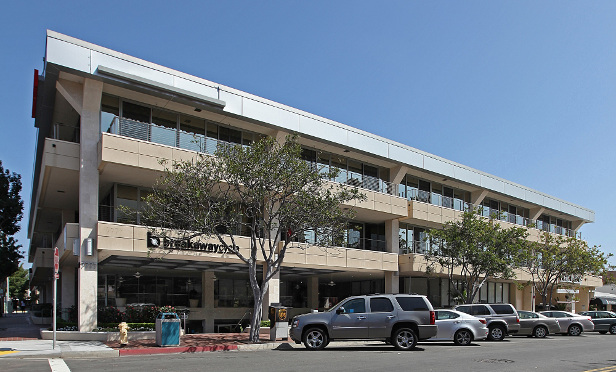 Aubry-Dumand: “La Jolla is no longer a sleepy market, but rather a trendy, hip place to be.”
Aubry-Dumand: “La Jolla is no longer a sleepy market, but rather a trendy, hip place to be.”
LA JOLLA, CA—With its real estate landscape transforming every day to the backdrop of a scenic, amenity-filled environment, La Jolla has quickly become one of the San Diego region’s most sought-after corporate locations, Cushman & Wakefield director Pascal Aubry-Dumand tells GlobeSt.com. Aubry-Dumand recently represented seller J.N. Daniel LLC in the sale of La Jolla Galleria, a 54,000-square-foot, class-A office building in historic Downtown La Jolla, to La Jolla Fay LLC for an undisclosed amount.
The buyer, represented by Bill Shrader with Colliers International, was a long-term tenant and exercised its right to purchase the building just 18 months after signing a long-term lease. Aubry-Dumand has also handled leasing for the property for the past 15 years.
We spoke with Aubry-Dumand about the La Jolla office market and why investors and tenants alike are drawn to this market.
 Pascal-Dumand has handled leasing for La Jolla Galleria for the past 15 years.
Pascal-Dumand has handled leasing for La Jolla Galleria for the past 15 years.
GlobeSt.com: How would you characterize the La Jolla office market?
Aubrey-Dumand: The La Jolla office market is a unique submarket bounded on the west by the Pacific Ocean—laced with numerous state parks, secluded coves and beaches—and bounded on the east by the University of California San Diego. The town of La Jolla has historically been one of the most exclusive residential communities in California, but above all, La Jolla is known for its “village,” a pedestrian shopping district that is home to a variety of cafés, boutiques and fine restaurants and offers some of the best views of the California coast. Composed of 1 million square feet of inventory, La Jolla’s office market can be characterized as active, transformative and fairly constrained, with a healthy 93% occupancy rate across all classes. Office businesses appear to be doing well here in the current market cycle, as sublease space remains inconsequential, with minimal availability. While driven by financial services and other professional-services users, La Jolla possesses a nice, diverse and evolving occupier mix that also includes software/technology users. More recently, the market has also seen new growth from public relations agencies as well as the beauty sector. Office vacancy in La Jolla has consistently trended downward in recent years, receding from more than 15% in 2013 to mid-6% at year-end 2016. La Jolla reported one of its strongest performances since the Great Recession in 2016 with 42,000 square feet of net absorption (occupancy growth), second to only 2014’s 47,000 square feet during this time frame. Overall asking rents have also pushed upward noticeably, now hovering in the low $3.00 per-square-foot full-service range. Further, La Jolla’s class-A sector, which comprises 30% of the building base, is ultra-tight with sub-4% vacancy at the close of 2016. Meanwhile, rents for class-A space have risen swiftly to $3.77, jumping nearly 20% over the last five years. Over the last three years, rents increasingly grew in annual increments of $0.10, $0.15 and $0.20, respectively (class-A rents climbed another 6% during 2016).
GlobeSt.com: What draws investors and tenants into this market versus other areas of San Diego?
Aubrey-Dumand: Investors remain drawn by the potential and limited supply of good investment opportunities La Jolla offers. La Jolla is no longer a sleepy market, but rather a trendy, hip place to be. Some of the best hotels, restaurants and retailers are in La Jolla, such as La Valencia Hotel, the Colonial Hotel, Nine Ten restaurant, Georges at the Cove, Eddy V’s, Duke’s and the Marine Room, to name a few. This type of vibrant, walkable, healthy and friendly coastal community, with an ideal climate, is the type of atmosphere many companies and their workforces are seeking. Notably, more than 20% of the leasing activity we saw in La Jolla in 2016 was via migration. Further, tenants are more attracted to higher-quality office buildings than ever before. Investors have certainly taken notice of this fact and have poured into La Jolla, focusing on its great potential and renovating and upgrading properties and putting this area in a better position to compete with other highly desirable areas like UTC and Del Mar Heights in terms of quality. Many companies have noticed this ongoing metamorphosis and have established offices here, whereas in prior years they likely would not have considered La Jolla as a primo choice. The “new economy” knowledge-based companies focus intently on the satisfaction and overall welfare of their employees, and for the new generation of employees, quality of life is paramount. As such, we continue to see real estate decision makers heavily influenced by the needs of their workforce, seeking a comfortable, good quality workplace, access to amenities, accessibility and other qualities that create a positive, energized environment and culture. With its real estate landscape transforming every day to the backdrop of a scenic, amenity-filled environment, La Jolla has quickly become one of the region’s most sought-after corporate locations.
GlobeSt.com: What trends do you see among class-A office properties in this submarket?
Aubrey-Dumand: With a moratorium on new construction higher than 5,000 square feet resulting in very high barriers to entry, existing buildings are being renovated to meet today’s higher-quality standard of real estate. This trend started a few years ago, and it does not appear that it will stop anytime soon. Tenants are loving what they see through this progressive transformation.
GlobeSt.com: What else should our readers know about the La Jolla office market?
Aubrey-Dumand: The Village in La Jolla is an extremely tight market with class-A direct vacancy in the mid-3% range. Further, there is a mere 11,000 square feet of vacant class-A space in the Village’s five total class-A buildings serving this very desirable, popular beachside community.

















 Copyright © 2024 ALM Global, LLC. All Rights Reserved.
Copyright © 2024 ALM Global, LLC. All Rights Reserved.